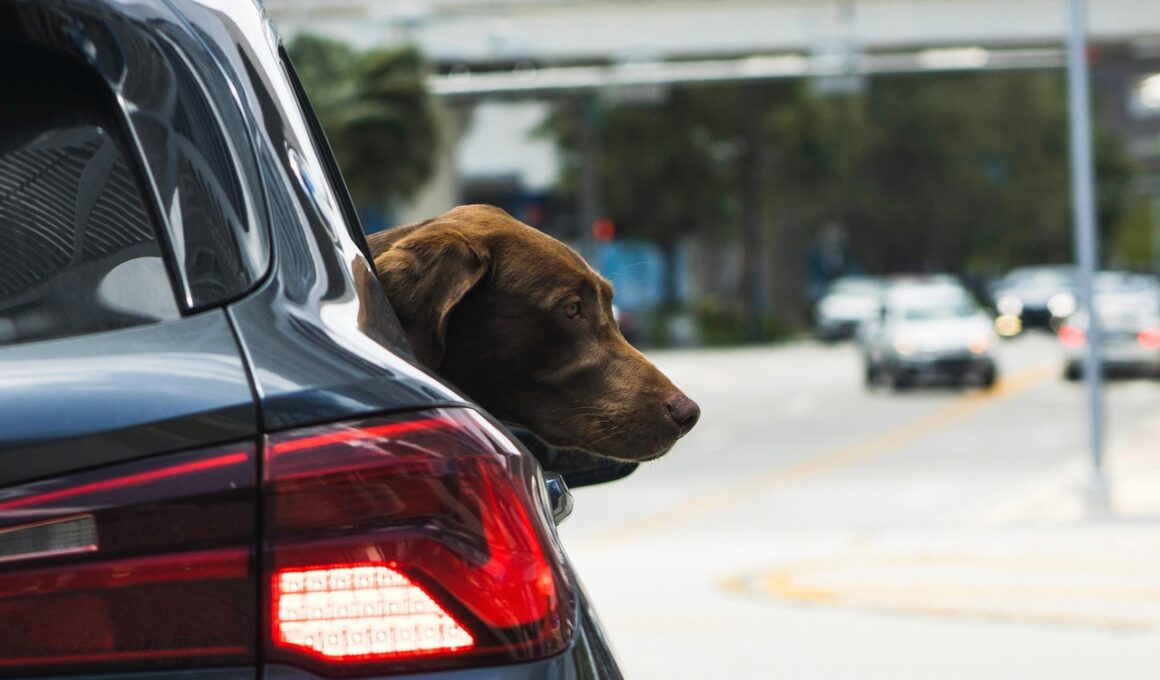Step-by-Step Guide to Preparing Your Dog for Car Trips
Traveling with your dog can be a delightful experience, but preparation is essential. Dogs are naturally curious, and being in a car can be both exciting and anxiety-inducing for them. Before you embark on a journey, ensure that your dog is well-prepped to make the ride safe and enjoyable for both of you. Start by introducing your dog to the car environment gradually. Allow them to explore without starting the engine initially. Use positive reinforcement by offering treats and praises when they show interest or calm behavior around the vehicle. This early interaction can alleviate any fear associated with car travel. Once your dog is comfortable, dedicate short trips around the neighborhood, gradually increasing the length of your travels. Ensure that your dog is secure in the vehicle by using a proper harness or crate. This not only guarantees their safety during abrupt stops but also prevents distractions while driving. Moreover, consult your veterinarian about medications that could ease anxiety if your dog is particularly nervous. Always have water and familiar items in the car to keep them comfortable. Lastly, be sure to take frequent breaks during longer trips.
Understanding Your Dog’s Behavior
Observing your dog’s behavior can provide critical insights into their comfort level during car travel. Each dog has a distinct personality, so understanding their signals can help you tailor your approach effectively. Some dogs may enjoy the ride, while others might experience signs of discomfort or stress. Vocalizations, pacing, and excessive panting can indicate anxiety. On the other hand, relaxation or curiosity usually demonstrates composure. To counteract anxiety, consider familiarizing your dog with calming music or pheromone sprays designed for dogs. Preparing an enjoyable environment can significantly reduce stress and promote comfort. A non-slip blanket or familiar bed in the backseat can create a safe space for them. Avoid feeding your dog just before a journey to minimize motion sickness, which can make traveling uncomfortable for them. Additionally, providing a favorite toy can sometimes distract your dog from any unease they might feel. Always monitor their temperament during travel. Knowing when they need a break for bathroom or exercise is vital in ensuring their happiness. Harmonizing your dog’s needs with travel essentials encourages a positive experience, reinforcing the desire for future excursions.
Before embarking on longer trips, it is crucial to have all necessary supplies ready for your dogs. Prepare a travel bag specifically for your dog that includes essentials like food, water, bowls, leash, waste bags, and a first aid kit. Additionally, you may want to include their favorite toys and a familiar blanket to help reduce anxiety. Frequent stops during long drives will allow your dog to relieve themselves and stretch their legs. When stopping, always ensure they are on a tight leash to prevent sudden darting into traffic. It’s essential to never leave your dog alone inside the car, especially in hot weather, as this can lead to heatstroke. Familiarize yourself with pet-friendly stops along your route where you can safely allow your dog some outdoor time. When on the road, avoid distractions by giving your dog attention only when it’s safe to do so. Furthermore, consider practicing safe loading techniques, allowing your dog to enter and exit the vehicle calmly. Gradual exposure to these practices will help your dog feel secure in the vehicle and content during travels.
Health Checks Before Travel
Before your travel journey, ensure your dog is in optimal health. A visit to the veterinarian will confirm that your dog is physically ready for travel. Discuss any potential travel-related health issues and seek advice on suitable medications. If your dog has a history of motion sickness, your vet may prescribe medication to ease their symptoms. Vaccinations may also be necessary depending on your travel destination, particularly if you are crossing state lines or entering dog parks. Keep your dog’s medical records handy while on the road, especially if you require veterinary assistance during the trip. Ensure that your dog is up-to-date with flea and tick prevention as outbreaks may occur in various environments. Alongside health checks, ensuring that your pet is microchipped or has an ID tag with current contact information will provide peace of mind in case they get lost. Regularly checking their condition throughout the travel will help you notice any early signs of discomfort or stress. Giving attention to these details will contribute to a smoother experience and ensure your furry friend remains happy and healthy.
During your car trip, maintaining a calm atmosphere can greatly benefit your dog’s experience. As a driver, your demeanor influences your dog’s behavior; staying relaxed can ease their anxiety. Monitor all your dog’s reactions and provide calming verbal reassurances throughout the journey. Make use of safe driving techniques to avoid sudden acceleration or harsh braking, which can startle your pet. Use harnesses or well-ventilated crates that keep them secure, allowing them to sit or lie down comfortably. Keep the car temperature moderate; dogs can easily overheat, so ensure sufficient ventilation. Offering water during stops is essential for hydration, especially if you’re traveling in warmer weather. Aim for consistency in routine so that your dog can anticipate activities, such as stopping for breaks or meals. Just as you would coordinate rest times for yourself, giving your dog regular intervals for physical activities is crucial during long drives. Offering short walks or bathroom breaks will keep their energy levels balanced and their spirits high. With this well-organized approach to car travel, you can enjoy the open road together, creating cherished memories along the way.
Post-Trip Recommendations
After returning from your trip, evaluate your dog’s behavior during the journey. Recognizing how well your dog adapted to car travel can provide valuable insights for future outings. Did they show signs of anxiety, or were they comfortable throughout the trip? Adjust your travel methods based on these observations to enhance future experiences. Post-trip attention is also important; check for any discomfort or signs of illness that may arise after travel, especially in the first few days. If your dog typically exhibits car sickness or anxiety, consider adjusting future car rides. You may implement relaxation techniques, including light exercise before the trip or using calming scents. Continue practicing safety protocols, ensuring proper restraints are used every time you embark on a journey. Construct a travel log to monitor your dog’s progress and adjust strategies. Incorporate routine check-ups with a veterinarian after extensive travels to ensure ongoing health. Lastly, remember to reward your dog after successful trips, reinforcing positive feelings toward car travel. This practice helps build a strong positive association, encouraging them to feel excited about future adventures.
Traveling with your dog can undoubtedly be a joyful experience filled with exploration and new adventures. By effectively preparing your dog through familiarization, comfort strategies, and health checks, you can create a positive environment conducive to stress-free traveling. Every dog can develop their travel habits over time, so start small by introducing them to short rides before embarking on more extended journeys. Monitor their responses closely, integrating methods that alleviate anxiety as necessary. Ensure you have all required supplies in advance and be prepared for unexpected situations. After your trip, reflect on different strategies that might enhance the experience for your dog in future outings. Fostering this bond through travel nurtures companionship and trust, encouraging enjoyable adventures together. Ultimately, each outing contributes to both you and your dog’s development and understanding of the world, making road trips highly rewarding. Celebrate your dog’s adaptability, and take joy in exploring the surroundings together. Following these steps will promote safe travel while strengthening the connection shared between you and your beloved pet.
Final Thoughts on Car Travel
In summary, preparing your dog for car travel is as imperative as planning the journey itself. Approach each trip with careful consideration, choosing practices and techniques to make the experience better for your pet. Remember always to stay observant of your dog’s reactions to gauge their comfort levels on the road. Gradually introducing them to the vehicle and ensuring a safe, calming space can significantly improve their car travel experience. Frequent monitoring for signs of stress or discomfort can prevent potential issues. It’s essential to maintain their health through pre-travel vet checks and ensure all safety measures are in place. Through these steps, both you and your dog can look forward to enjoyable and enriching journeys filled with memorable experiences. As you travel together, you’ll cultivate a rewarding partnership that only strengthens through shared adventures. Each trip can be an opportunity for continued bonding, providing endless options for exploration and discovery. Making your dog a travel companion can create lasting memories for years to come, enhancing the relationship you share with your pet. Adventure awaits, and with the right preparation, you and your dog will be ready for any road ahead.


